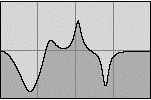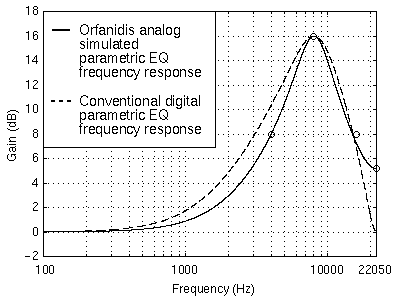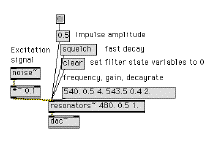
We introduce three new Max/MSP signal processing extensions
that efficiently implement IIR filters: biquadbank~, peqbank~
and resonators~. After describing their common properties, specific
features and new support objects, we conclude the paper with a
summary of their musical applications.
We have developed three new filter extensions for the Max/MSP
environment (Zicarelli, 1998), biquadbank~,
peqbank~ and resonators~ and some ancilliary extensions for control-parameter
interpolation, transformation and graphical display of phase and
frequency response functions.
This section will describe features common to all of our filter objects; subsequent sections will describe each object individually.
Standard Max/MSP filter objects such as biquad~ and lores~
implement variants of a single second-order IIR filter. Our new
objects implement multiple filters, the number of which can be
changed in real-time. For biquadbank~ and peqbank~ the filters
are cascaded in series: the output of one feeds the input of the
next. Resonators~ implements a parallel bank of filters with a
common input and summed output. Building multiple filters in a
single object allows more efficient use of processor and memory
resources than is possible patching together individual Max objects.
The objects obtain their efficiency by exposing multiple opportunities
for parallelism to the C compiler (Dowd
and Loukides, 1993, Freed,
1993, Freed and Chaudhary,
1998). On PowerPC G3 processors this results in good cache
utilization and efficient pipelining of the floating-point multiply
and add units. Exposing such parallelism is essential to achieve
the potential of new processor features such as the vector arithmetic
of the PowerPC G4 or the very long instruction word (VLIW) of
the Intel IA-64.
Other important advantages of implementing multiple filters in
a single object include simplified patching, support for concurrent
update of the control parameters and the ability to change the
number of filters in real-time.
The standard Max/MSP filter objects do not implement smooth control
parameter changes, resulting in audible clicks and zippering,
which are unacceptable audible artifacts in time-varying filter
applications (Ding and Rossum, 1995).
Our new objects offer a smooth mode and a fast mode. The former
is for time-varying applications and the latter, approximately
20% faster, is for fixed parameter situations.
Filter properties are controlled by sending a list of parameter
values. The interpretation of the list data is determined by a
message name preceding floating-point parameters. This allows
the objects to interpret many variant ways of describing filters.
A further advantage of binding all the control parameters into
a single list is that the objects can update the filters simultaneously.
After each filter parameter update, the objects output a list
containing the filter coefficients in a standard form for display
or debugging. One of the authors has developed a new Max user
interface object, filtergraph~, shown in Figure 1 graphing the
frequency response of a cascade of biquads. Filtergraph~ will
be available as part of a future MSP release.

This is the multi-filter, cascaded generalization of the standard
biquad~ object, with the optional smooth mode described above.
The object is useful when direct control of the filter coefficients
is required.

This object (shown in Figure 2) adds a real-time filter coefficient design layer to a cascaded biquad filter bank. It supports two shelving equalizers and an arbitrary number of parametric equalizers. This object implements the latest theoretical work on parametric equalizer design (Orfanidis, 1997), i.e., a transfer function that models that of an analog equalizer more accurately at the Nyquist frequency. The figure below compares the frequency response of the classical approach for a parametric peaking EQ with the analog simulation approach. The center frequency, gain, and bandwidth are the same in both cases. The analog simulation avoids unnecessary high-frequency attenuation and exhibits better symmetry around the peak frequency, as illustrated in Figure 3.

This object implements parallel banks of two-pole resonators.
Real-time coefficient design is performed to map frequency, gain,
and decay rate into filter coefficients:

Impulses sent to resonators~ as floating-point messages are
scaled internally to obtain the correct impulse response of the
resonator bank. Signal inputs are scaled according to a more conservative
criterion that lowers the gain of narrow band filters to avoid
output overflow for inputs with energy at center frequencies of
sharp resonators.
The res-transform object was developed to store and manipulate
models of resonance (Potard, et al.,
1985, Potard, et al., 1986).
It accepts list messages specifying resonance model data in a
variety of formats. The transformations supported include spectral
envelopes, pitch transposition, bandwidth and gain scaling. The
res-transform object outputs the transformed model on receipt
of a bang message.
In Figure 5, the res-transform output is sent to a resonators~
object and also to an extended version of the Max LCD object.
A new drawing primitive was added to display the models in a convenient
2-D form developed originally as an extension to MacMix (Freed,
1985, Freed, 1987) for
use on the Reson8 digital signal multiprocessor (Barriere,
et al., 1989).

The smoothing function of resonators~ (and the other filter
objects) operates by linear interpolation in the filter coefficient
space. This efficient scheme has no filter instability problems
(Moorer, 1989). However, for large
filter parameter changes the interpolated filters may be unsatisfactory
from a musical perspective. We therefore employ a nested interpolation
scheme where coefficient interpolation operates for short vectors
of the order of 2ms and filter specification parameters are interpolated
at slower rates determined by the Max event scheduler.
This interpolation model required us to create a new object, list-interpolate,
which is useful in many different situations. This object accepts
lists and outputs an interpolation of the last lists received
according to an interpolation factor sent as a float message.
As well as smoothing parameter changes, this object may be used
for timbral interpolation.
Edmund Campion used resonators~ in the world premier of "Play-Back"
on June 7, 1999. Jean-Baptiste Barrière used the same object
in a May 1999 installation called "Autoportrait in motion"
presented at the Festival International des Musiques Électroacoustiques
de Bourges in France.
We are using resonators~ to create a reference implementation
of the SDIF standard in Max/MSP (Wright,
et al., 1999).
Open Sound Edit (Chaudhary and Freed,
1999) uses Open Sound Control (Wright
and Freed, 1997) to message a resonator model synthesizer
built around resonators~.
We have used peqbank~ and resonators~ extensively to develop
new polyphonic guitar effects based on vocal-tract modeling, frequency
localized distortion and coordinated equalization.
We are using resonators~ to model the decay of low-pitched
organ tones.
We are extending resonators~ to support more general damped
exponential models coded in SDIF (Wright,
et al., 1999); of particular urgency is the incorporation
of new methods to provide more user control over input scaling.
We are developing new, complementary objects for FIR filtering
and convolution.
We have implemented resonators~ in a new real-time music programming
environment, Open Sound World (OSW) and will soon port the remaining
filter objects to the OSW C++ extensions framework (Chaudhary,
et al., 1999).
We gratefully acknowledge the support of Gibson Guitar Inc, and the O'Neill foundation.
J.-B. Barriere, P.-F. Baisnee,
A. Freed, and M.-D. Baudot (1989), "A Digital Signal Multiprocessor
and its Musical Application," presented at 15th International
Computer Music Conference, Ohio State University.
A. Chaudhary and A. Freed (1999),
"Visualization, Editing and Spatialization of Timbral Resources
using the OSE Framework," presented at Audio Engineering
Society 107th Convention, .
A. Chaudhary, A. Freed, and M. Wright
(1999), "An Open Architecture for Real-Time Audio Processing
Software," presented at Audio Engineering Society 107th Convention,
.
Y. Ding and D. Rossum (1995), "Filter
morphing of parametric equalizers and shelving filters for audio
signal processing," Journal of the Audio Engineering Society,
vol. 43, num. 10, pp. 821-6.
K. Dowd and M. K. Loukides (1993),
High performance computing. Sebastopol, CA: O'Reilly &
Associates.
A. Freed (1985), "MacMix: Mixing
Music with a Mouse," presented at Proceedings of the USENIX
Association Second Computer Graphics Workshop, Monterey, CA, USA.
A. Freed (1987), "Recording,
mixing, and signal processing on a personal computer," presented
at Proceedings of the AES 5th International Conference: Music
and Digital Technology, Los Angeles.
A. Freed (1993), "Guidelines
for signal processing applications in C," C Users Journal,
pp. 85(9).
A. Freed and A. Chaudhary (1998),
"Music Programming with the new Features of Standard C++,"
presented at International Computer Music Conference, Ann, Arbor,
Michigan.
J. Moorer (1989), personal communication.
S. J. Orfanidis (1997), "Digital
parametric equalizer design with prescribed Nyquist-frequency
gain," Journal of the Audio Engineering Society, vol.
45, num. 6, pp. 444-55.
Y. Potard, P.-F. Baisnée,
and J.-B. Barriere (1985), "Models of Continuity between
Synthesis and Processing for the Elaboration and Control of Timbre
Structures," presented at International Computer Music Conference,
Vancouver.
Y. Potard, P.-F. Baisnée,
and J.-B. Barriere (1986), "Experimenting with Models of
Resonance Produced by a New Technique for the Analysis of Impulsive
Sounds," presented at International Computer Music Conference,
La Haye.
M. Wright and A. Freed (1997), "Open
Sound Control: A New Protocol for Communicating with Sound Synthesizers,"
presented at International Computer Music Conference, Thessaloniki,
Greece.
M. Wright, S. Khoury, R. Wang, and
D. Zicarelli (1999), "Supporting the Sound Description Interchange
Format in the Max/MSP Environment," presented at International
Computer Music Conference, Beijing, China.
D. Zicarelli (1998), "An Extensible
Real-Time Signal Processing Environment for Max," presented
at International Computer Music Conference, Ann Arbor, Michigan.